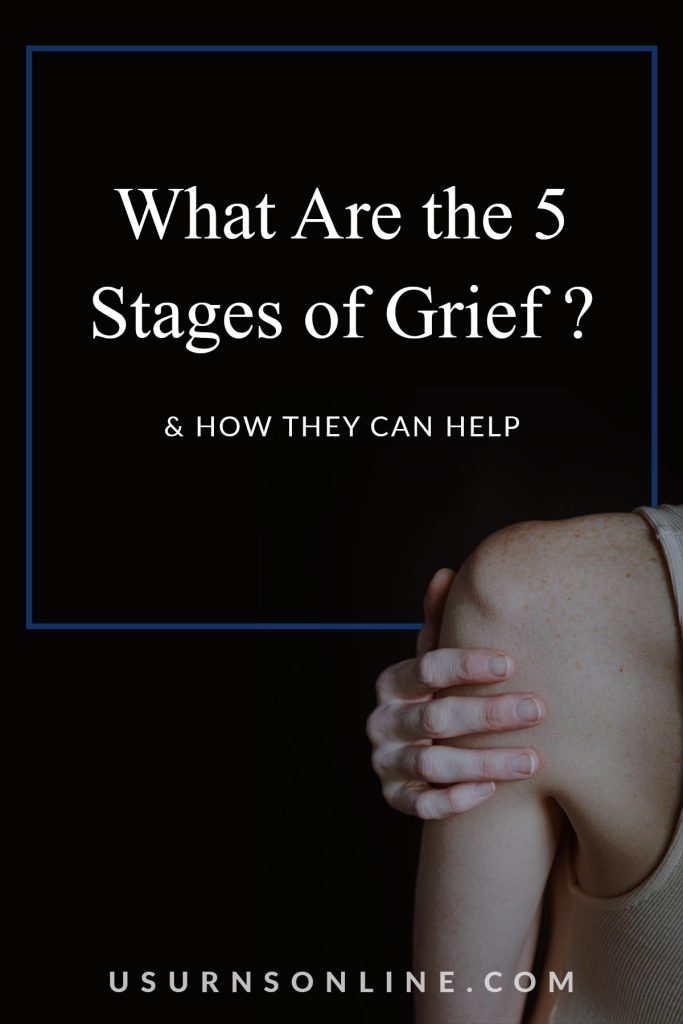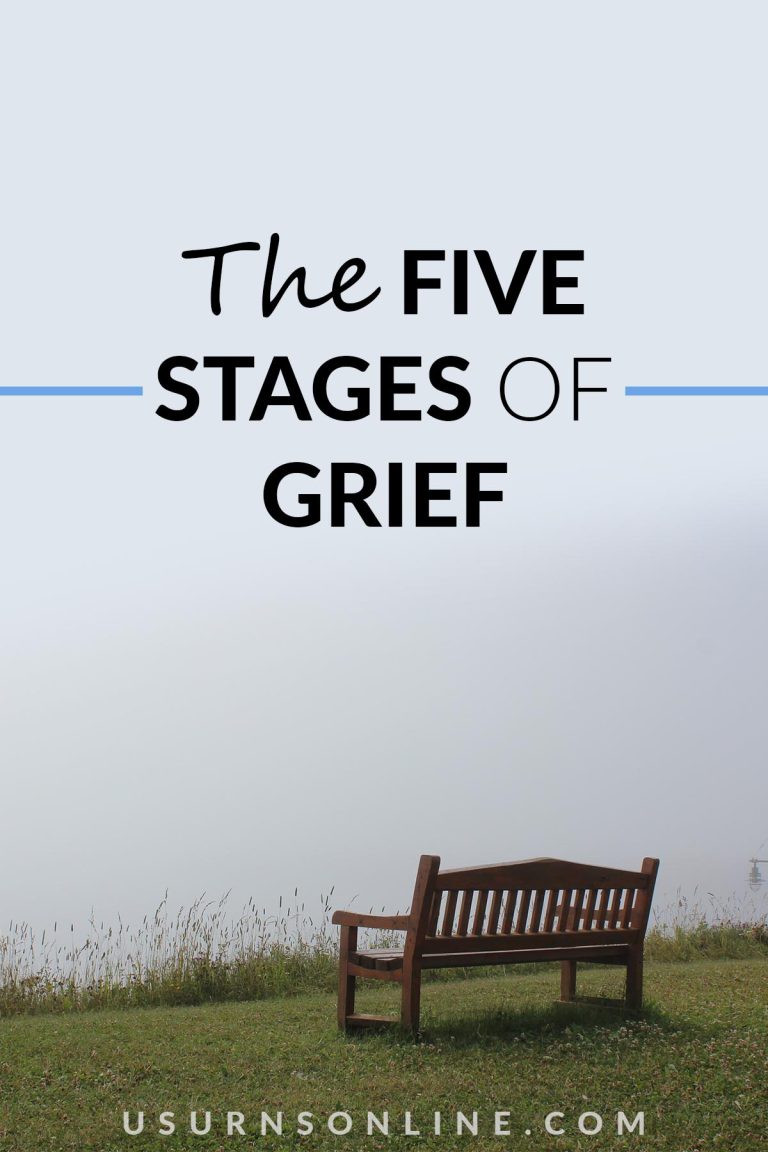The 5 stages of grief provides an easy-to-remember blueprint that helps us understand the grieving process.
It’s not a perfect or completely comprehensive formulation. But it has become incredibly popular and pervasive because effectively teaches us that the experience of grief:
- changes over time,
- looks different for each person, yet
- bears identifiable similarities to the experience of others who have lost a loved one.
Continue reading to learn about this basic theory on grief and what the stages can mean in your life.
The Five Stages of Grief
Grief hits us in stages. It comes and goes. Jumping from stage to stage only to revisit something we thought we had already worked out.
Working through grief is hard, and there is no set timetable. It’s a personal journey, and it must be traveled at your own pace.
Here are the five stages of grief – but note that this list doesn’t encompass all of the emotions you will feel.
- Denial
- Anger
- Bargaining
- Depression
- Acceptance
Origin
Dr. Elisabeth Kubler-Ross (a Swiss-American psychiatrist) established the five stages of grief model in 1969. Also called the DABDA model, many doctors, therapists, and professionals the funeral industry accept it.
Kubler-Ross has studied the fact that we all go through grief differently. But these five emotions/stages seem to hit all of us. This doesn’t mean you will go through all five stages, but you will experience at least one or more of them.
While the order of the five stages is important, Kubler-Ross has stated that the five stages do not always follow that same order. You may start off with depression or anger. You might even work through the anger stage only to have it revisit you at a later date. This is normal.
Let’s take a closer look at each of the five stages in turn.
Urns Made in the USA
Denial
The denial stage of grief is usually the first reaction. You don’t want to believe the doctor’s report. The findings are wrong or not even intended for you or your loved one.
It’s the reaction that causes you to say, “This can’t be happening to me.”
Denial isn’t just about rejecting the fact of death. It can take many forms. For instance, even telling people, “I’m fine” can be a form of denial.
Anger
The anger stage of grief is when you realize that you can no longer “deny” or fight against the situation.
You become angered at the diagnosis, the people around you, even the doctors and nurses. You might take your anger out on your loved one that is ill. “Why didn’t you take better care of yourself?”
You can become angry at yourself: “I’m so stupid for not… [driving the car, noticing the warning signs, finding better treatment, etc.]” Or you may even direct your anger towards God: “How could You allow this to happen? This is so unfair!”
Bargaining
The bargaining stage of grief is often a stage you will go through after a diagnosis. You might bargain with God. Asking for more time, asking for healing, or praying the doctor gave you a misdiagnosis.
People also often try to bargain with medical professionals. Bringing in new experts or specialists, pleading for them to try one more operation, pursuing a pharmaceutical still in the testing phase, looking to alternative medicine, and so on. These can all be forms of bargaining.
Depression
The depression stage of grief comes in at stage four; but remember, this doesn’t mean it will be stage four for you. This is the hopeless feeling of not wanting to go on.
The depression phase may find you turning inward and refusing to communicate with the outside world. You may become overwhelmed and feel hostile towards anyone in your circle.
Acceptance
Acceptance of grief is the fifth and final stage in the Kubler-Ross model. This is where you accept the fact that your loved one (or perhaps yourself) is actually going to die. You realize that there is nothing you can do to stop it. The doctor gave the correct diagnosis from the start.
Or, if you reach this stage after the death of your loved one, it can be a form of coming to terms with this new reality without them by your side. The grief and pain is still there, and emotions from the other stages may still arise at times. But internally you have come to terms with the death.
When you reach the fifth stage of grief, you begin to plan on how you will move on with your life. This might take the form of a planned vacation that helps you begin to heal from your grief and misery in the future.
Two more stages of grief
Elisabeth Kubler-Ross established her list of 5 stages of grief, other people have proposed more stages over the years. Most commonly, the model is expanded to 7 stages of grief:
- Shock or disbelief. This is the stage where the numbness can set in. You can’t believe your loved one has passed. You may be surprised by death, even though you were expecting it, but you do not feel the devastation normally felt at the time of loss.
- Guilt. This is the stage you may feel if you had any unresolved issues before the death of your loved one occurred. You may also have survivor’s guilt. You could even have the wish to turn back the clock and “redo” some of life’s moments.
How long do the stages of grief last?
Grief is highly personal. Thus it is different for every person that works through it.
There are no limits to grief. You may start to feel little things getting better. Sleeping might be easier, or getting out of bed in the morning might get a little less difficult. People have reported that they may start to feel better after a few months. Some people report it takes years.
In my honest opinion, there is just no set time. We all grieve at our own pace. There is no right or wrong.
Related: Prolonged Grief: What it is, and what it looks like
Order of the 5 stages
The stages of grief can assail you in any order. Working through the hardships of one stage doesn’t mean it will not come back to haunt you again.
You may have conquered depression months ago, only to find that a certain song, smell, or memory will assault you. The depression may come rushing back on you, and it could very well be worse than before.
The best way to handle this potential is to learn about it ahead of time and understand that it is not abnormal. Also, be sure to surround yourself with a support network of friends and family members, or a grief recovery support group like GriefShare.
Physical symptoms
Grief can wreak havoc on you, not just mentally, but physically too.
Here are a few of the ailments you may develop.
- Bereavement can worsen health problems you may already have.
- Grief can increase blood pressure and chest pains.
- Grief might increase your chances of developing a blood clot.
- Stress is common during grief.
- Heart palpitations and even a heart attack may happen.
- Suffering from grief can be a major cause of insomnia.
This is a shortlist of physical ailments. If you feel anything out of the ordinary or worrisome, do not hesitate to see your doctor. It is so important to make sure to stay healthy. You matter.
For more information about this, click here.
Is any one stage harder than the others?
Everyone has their own “hardest” stage of grief. Yet, it seems the stage most people agree on as the hardest is acceptance. Accepting your loved one is gone is agonizing. This is when you feel that your entire world is coming to an end. No one wants to face the fact that this chapter has been closed on their life.
Acceptance will mean that you have to admit your loved one is gone. There is no turning back. There is no getting your loved one back.
Learning to live differently is what it comes down to. This might mean you have to get a job, sell your home, or even move back with your parents. Remember, you do what is right for you.
Take care of yourself. If you have children, keep in mind that they are hurting too. Children don’t process grief the same way as adults do.
How this model can be helpful
Grief models like the 5 stages can be helpful by letting you understand what you are feeling is normal. You aren’t alone in your sorrow or other feelings.
Grief can often be a confusing time. Each of the five stages is very different from the others. So, it can be reassuring to know that everyone goes through grief – be it from death or life’s disappointments – in recognizable ways.
How this model can be unhelpful
Grief models may be meaningless if you expect to follow one verbatim. People will hardly ever go stage by stage when they are grieving. The models may confuse you if you think they will be a 100% accurate portrayal of grief.
Don’t rely on the models to tell you when grief is over. The models usually end with acceptance. However, most people’s grief will continue long after you accept that your loved one is gone.
For instance, the anniversary of your loved one’s death, their birthday, your wedding anniversary, or the holiday season can all be difficult times of the year for anyone who has lost a loved one. This is completely normal.
Related: Normal Grief: 10 Things to Know About the “Typical” Grieving Process
10 Things to Know About the 5 Stages of Grief
The rawest pain you will ever feel is the death of a loved one. It can feel like a gaping wound that refuses to heal. Death is the worst thing you may ever cope with, but grief can also cover several other losses.
We need to be mindful of our friends, family, and coworkers. We don’t know who may be going through the grieving process. It could be over the loss of a job, loss of a promotion, loss of a relationship, or a disappointment. At some point, we all grieve. Grief is a universal emotion.
I put together a list of points to know about the 5 stages of grief and related models. Read on and learn a few tips to help yourself or someone you know, working through grief.
1. Recognizing disenfranchised grief isn’t always easy.
People won’t always sympathize with you when you are going through a personal loss that doesn’t encompass death. Don’t let their disregard hurt your feelings.
The grief you are feeling is real and natural. The experts refer to this as disenfranchised grief. This grief can be just as painful as losing a loved one to the person pushing through it.
2. “Time heals all wounds” does not cover the death of a loved one.
Well-meaning people say this, or maybe people that don’t think it through might use this phrase. In your own time, you will heal – but still, you will never be the same. Make an effort and take the time you need.
Related: Words to Comfort Those That Lost a Loved One
3. Grief models are not set in stone.
You won’t always go through each stage. And you may not go through each stage just one time. The stages probably won’t come in the order you expect.
4. Grieving models can give the impression that once you “accept” the death, you will miraculously be healed from your grief.
This is not true. Your grief for your loved one will come and go for the rest of your life. Music, scents, meals, photos, or even locations will bring back memories when you least expect it. These memories may cause joy or grief – or both. These are emotions that are very common for mourners to feel.
You may find contentment knowing that as life goes on, the sharpness of your grief will lessen. Instead of sadness, you may begin to find comfort in your memories.
5. Your grief for your loved one will come and go for the rest of your life.
Accepting your loved one’s passing does not magically switch your love off. Love is not a finite emotion. Your love now reaches beyond this time and place.
You may learn to compartmentalize your love, but it will continue to live on. Grief will continue to visit you; it should soften over time, though.
6. You will have good days and bad days.
It is normal to have wavering emotions. Acceptance one day, regret the next, and loss of faith in all of it. Losing the faith doesn’t always mean in God. It can be losing faith in the future, in yourself, or in ever feeling normal again. But trust me; this is all very “normal.”
7. Your grief will look different depending on your coping mechanisms.
Grief symptoms may appear differently in each person. Symptoms may manifest physically, emotionally, or even socially.
Social symptoms can show themselves in how you relate to other people. You may be isolating yourself. You may feel like no one understands you, or that you don’t want to be around others in your sorrow. Alone time is nice, but you should have a support system in place.
8. There is hope.
As difficult as this process of grieving is, the majority of people will work through it successfully.
Some people skip stages, some people work through grief quickly, you may be slower and that is okay. Your loved ones and friends are on your side, and so are statistics!
9. There is a Part 2 for the stages of grief: Testing your new life.
Dr. Kubler-Ross refined her model after a few years. She added the “Testing” stage. This is where you recognize that grief is affecting your life, and you begin to try to find ways to survive realistically.
You may try new ways to cope and to feel better emotionally. This might include increased or decreased thoughts of your loved one – ideally, this would change in the direction that helps create a healthier balance. It could also mean new relationships, or a renewed focus on your children or friends. It could be a fresh start with a new job or a relocation.
10. Grief models vary.
Grief models will vary, but they all agree on one thing: The death of your loved one must be accepted before you can truly move on. Moving on doesn’t mean forgetting. It means having a starting point for your new life. Not a life you would have chosen, but it is your life now. It is important to live to your fullest and happiest.
Other Models for the Stages of Grief
- Elisabeth Kubler-Ross came up with the Five Stages of Grief. Her work with terminally ill patients coming to their own sense of mortality helped shape her understanding of these stages.
- Dr. Therese Rando presented The 6 R’s:
- Recognize your loss.
- React: You will react emotionally to their loss.
- Recollect and Re-experience: People will review memories of their relationship.
- Relinquish: Accept that your world has changed and there is no going back. Let go.
- Readjust: You will begin returning to a daily routine.
- Reinvest: You may begin to accept your changes and move past them. Perhaps forming a new relationship or commitment.
- Granger Westburg has created ten stages of grief in his book Good Grief.
- Shock
- Emotion
- Depression
- Physical Distress
- Panic
- Guilt
- Anger
- Resistance
- Hope
- Acceptance
Always remember that grief models are theories. They present a thesis, but nothing is proven or definitive. Some doctors, counselors, and other brainy people may conclude “this is how grieving works.”
Chances are, you will feel so much more than these models could ever guess. The stages vary. Some will be longer than others. Others might be skipped altogether. Some might be revisited time and again.
How to Grieve Well Through the Stages
You matter. You do not have to go through your grief alone. There are many sources for help with how to grieve well.
One healthy way to work through your grief is by working. Continue to do daily chores and tasks. Take care of yourself, your children, and your emotional well being.
Beyond your own introspection, it is important to have a support system. Keep in contact with friends and family members. Let people in, at least to some degree. Search “grief support in my area” and find a local group. Knowing you have support will give you security as you navigate these unexplored waters.
For more, read our article on Mourning a Death: How to Grieve Well.
Read Next: Types of Grief: The 16 Ways People Grieve





